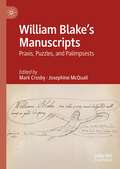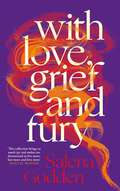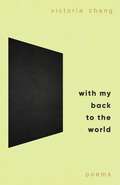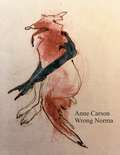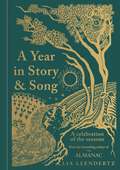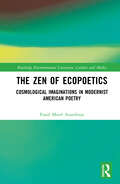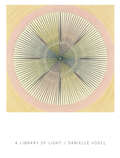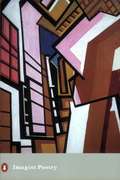- Table View
- List View
William Blake's Manuscripts: Praxis, Puzzles, and Palimpsests
by Mark Crosby Josephine A. McQuailThis collection of essays examines how close analysis of William Blake’s manuscripts can yield new discoveries about his techniques, his working habits, and his influences. With the introduction of facsimile editions and more particularly, the William Blake Archive, the largest digital repository of Blake materials online, scholars have been able to access Blake’s work in as close its original medium, leading to important insights into Blake’s creative process and mythopoetic system. Recent advancements in digital editing and reproduction has further increased interest in Blake’s manuscripts. This volume brings together both established Blake scholars, including G.E. Bentley Jnr’s final essay on Blake, and upcoming scholars whose research is at the intersection of digital humanities, critical theory, textual scholarship, queer theory, transgender studies, reception history, and bibliographical studies. The chapters seek to cover the breadth of Blake’s manuscripts: poetry, letters, notebook entries, and annotations. Together, these chapters offer an overview of the current state of research in Blake studies on manuscripts at a point when his manuscripts have become increasingly available in digital environments, and gesture to a possible future of Blake scholarship in general.
With Love, Grief and Fury
by Salena GoddenWith Love, Grief and Fury contains love poems, for people and the planet; grief poems brimming with compassion, sharing tears and mourning what was and contemplating what could be; and poems of fire and fury that will kick some ass, tell the truth and inspire change and hope. Over thirty years after she first stormed the UK poetry scene, the trailblazing and award-winning writer Salena Godden has produced her most audacious and definitive collection to date. Like a big sister’s arm around your shoulder, With Love, Grief and Fury is important and nourishing for the soul.
With My Back to the World
by Victoria Chang'Chang has liberated the Ekphrastic form to new lyric heights and depths. Inventive, meditative, audacious, strange and soulful. A marvel of a collection that engages the eye and mind as much as the ear and heart' Raymond AntrobusYesterday I slung my depression on my back and went to the museum. I only asked four attendants where the Agnes painting was and the fifth one knew. I walked into the room and saw it right away. From afar, it was a large white square.WITH MY BACK TO THE WORLD engages with the paintings and writings of Agnes Martin, the celebrated abstract modern artist, in ways that open up new modes of expression, expanding the scope of what art, poetry, and the human mind can do. Filled with surprise and insight, wit and profundity, the book explores the nature of the self, of existence, life and death, grief and depression, time and space. Strikingly original, fluidly strange, Victoria Chang's new collection is a book that speaks to how we see and are seen.
Wrong Norma: ‘I would read anything she wrote’ Susan Sontag
by Anne CarsonWrong Norma is Anne Carson's first book of original material in eight years'If she was a prose writer she would instantly be recognised as a genius'COLM TÓIBÍN, author of Brooklyn'I'm a big fan... She pinpoints the collision of oracle and anachronism'TEJU COLE, author of TremorAs with her most recent publications, Wrong Norma is a facsimile edition of the original hand-designed book, drawn and annotated by the author. Several of the twenty-five startling poetic prose pieces have appeared in magazines and journals like the New Yorker and the Paris Review.Anne Carson is probably our most celebrated living poet, winner of countless awards and routinely tipped for the Nobel Prize in Literature. Famously reticent, asking that her books be published without cover copy, she has agreed to say this:Wrong Norma is a collection of writings about different things, like Joseph Conrad, Guantanamo, Flaubert, snow, poverty, Roget's Thesaurus, my Dad, Saturday night, Sokrates, writing sonnets, forensics, encounters with lovers, the word "idea", the feet of Jesus, and Russian thugs. The pieces are not linked. That's why I've called them "wrong".
A Year in Story and Song: A Celebration of the Seasons
by Lia LeendertzA Year in Story and Song is a captivating collection of stories and songs that celebrates the seasons. We humans love stories. We love to hear them and to tell them, around fires and by bedsides, and we love to use them to make sense of the world around us. The seasons, in all their ever-changing variety, give us many opportunities for storytelling: the full moons and their names, Epiphany in January, St Patrick's Day in March, May Day, Midsummer, Halloween and more. They feature mischievous boggarts and fairies, saints and sailors, leprechauns and dragons, pilgrimages and charms, milk maids and rose queens, Robin Hood and the green man. The songs range from shanties and love songs, to bawdy ballads and wassails, to carols and rounds, and have been sung for hundreds of years, often at particular moments in the calendar.This is a book to treasure all year, every year.
The Zen of Ecopoetics: Cosmological Imaginations in Modernist American Poetry (Routledge Environmental Literature, Culture and Media)
by Enaiê Mairê AzambujaThis book is the first comprehensive study investigating the cultural affinities and resonances of Zen in early twentieth-century American poetry and its contribution to current definitions of ecopoetics, focusing on four key poets: William Carlos Williams, Marianne Moore, Wallace Stevens, and E.E. Cummings. Bringing together a range of texts and perspectives and using an interdisciplinary approach that draws on Eastern and Western philosophies, including Zen and Taoism, posthumanism and new materialism, this book adds to and extends the field of ecocriticism into new debates. Its broad approach, informed by literary studies, ecocriticism, and religious studies, proposes the expansion of ecopoetics to include the relationship between poetic materiality and spirituality. It develops ‘cosmopoetics’ as a new literary-theoretical concept of the poetic imagination as a contemplative means to achieving a deeper understanding of the human interdependence with the non-human. Addressing the critical gap between materialism and spirituality in modernist American poetry, The Zen of Ecopoetics promotes new forms of awareness and understanding about our relationship with non-human beings and environments. It will be of interest to scholars, researchers, and students in ecocriticism, literary theory, poetry, and religious studies.
The Zen of Ecopoetics: Cosmological Imaginations in Modernist American Poetry (Routledge Environmental Literature, Culture and Media)
by Enaiê Mairê AzambujaThis book is the first comprehensive study investigating the cultural affinities and resonances of Zen in early twentieth-century American poetry and its contribution to current definitions of ecopoetics, focusing on four key poets: William Carlos Williams, Marianne Moore, Wallace Stevens, and E.E. Cummings. Bringing together a range of texts and perspectives and using an interdisciplinary approach that draws on Eastern and Western philosophies, including Zen and Taoism, posthumanism and new materialism, this book adds to and extends the field of ecocriticism into new debates. Its broad approach, informed by literary studies, ecocriticism, and religious studies, proposes the expansion of ecopoetics to include the relationship between poetic materiality and spirituality. It develops ‘cosmopoetics’ as a new literary-theoretical concept of the poetic imagination as a contemplative means to achieving a deeper understanding of the human interdependence with the non-human. Addressing the critical gap between materialism and spirituality in modernist American poetry, The Zen of Ecopoetics promotes new forms of awareness and understanding about our relationship with non-human beings and environments. It will be of interest to scholars, researchers, and students in ecocriticism, literary theory, poetry, and religious studies.
A Library of Light (Wesleyan Poetry Series)
by Danielle VogelWhen poet Danielle Vogel began writing meditations on the syntax of earthen and astral light, she had no idea that her mother's tragic death would eclipse the writing of that book, turning her attention to grief's syntax and quiet fields of cellular light in the form of memory. Written in elegant, crystalline prose poems, A Library of Light is a memoir that begins and ends in an incantatory space, one in which light speaks. At the book's center glows a more localized light: the voice of the poet as she reflects, with ceremonial patience, on the bioluminescence of the human body, language's relationship to lineage, her mother's journals written during years of estrangement from her daughter, and the healing potential of poetry. A mesmerizing elegy infused with studies of epigenetic theory and biophotonics, A Library of Light shows that to language is to take part in transmission, transmutation of energy, and sonic (re)patterning of biological light.[sample poem]When we are. When we are there, we lay together and cover ourselves with our voices. When we are ten, we are also twenty-one. We speak of breathing, but this is a thing we cannot do. When we are seven, we are also eighteen. When we are eighteen, we begin our bodies. But we are unmappable,unhinged. A resynchronization of codes, thecrystalline frequencies of stars, seeds, vowels, lying dormant within you. We are the oldest dialect. Asound the voice cannot make but makes.
Imagist Poetry (Penguin Modern Classics)
by Peter JonesImagism was a brief, complex yet influential poetic movement of the early 1900s, a time of reaction against late nineteenth-century poetry which Ezra Pound, one of the key imagist poets, described as ‘a doughy mess of third-hand Keats, Wordsworth … half-melted, lumpy’. In contrast, imagist poetry, although riddled with conflicting definitions, was broadly characterized by brevity, precision, purity of texture and concentration of meaning: as Pound stated, it should ‘use no superfluous word, no adjective, which does not reveal something … it does not use images as ornaments. The image itself is the speech’. It was this freshness and directness of approach which means that, as Peter Jones says in his invaluable Introduction, ‘imagistic ideas still lie at the centre of our poetic practice’.
